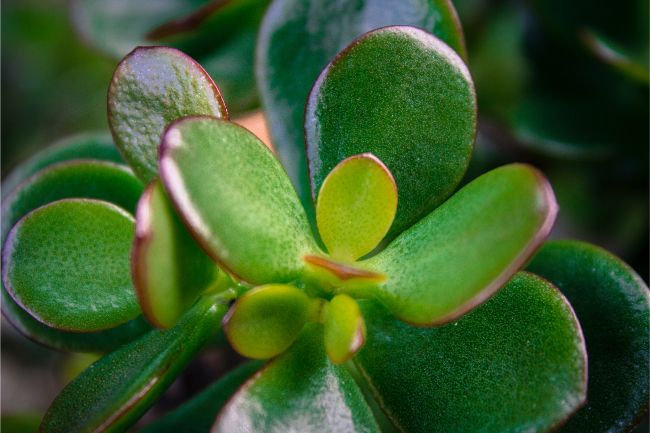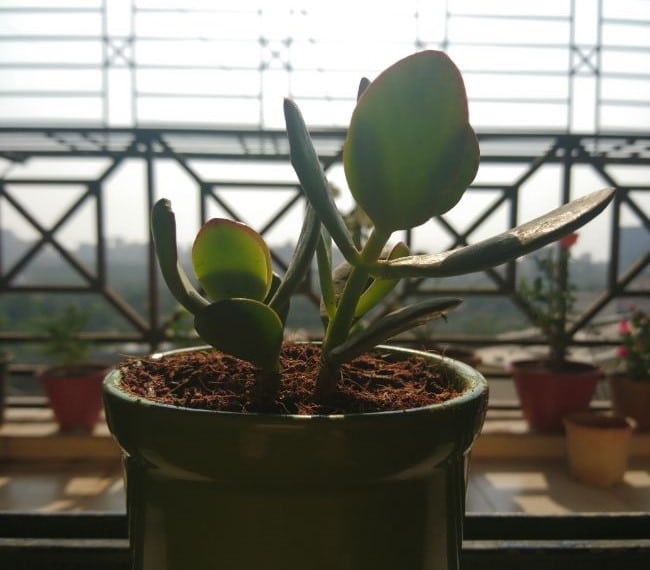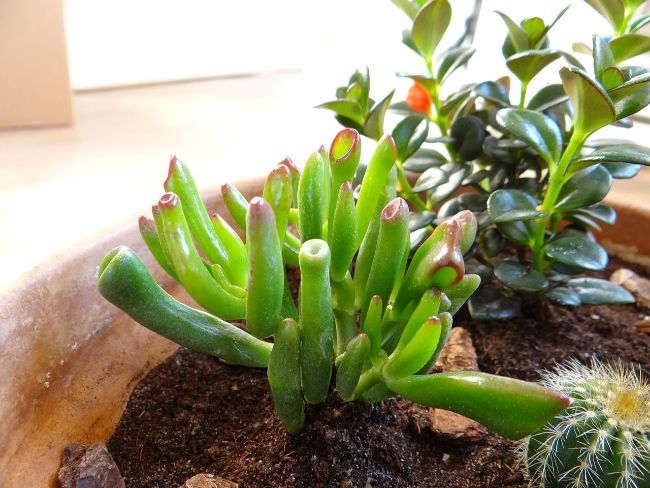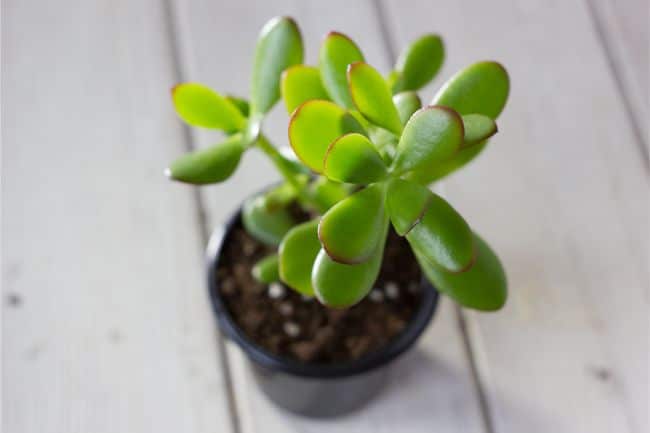Jade plants (Crassula ovata) are some of the easiest to grow and hardiest houseplants making them the perfect choice for the beginner or lazy indoor gardener. However, if you start to see your jade plant turning red it can leave you wondering what’s wrong with it and what you need to do to fix the problem.
Why Is My Jade Plant Turning Red? Several factors naturally influence a Jade plant turning red, including extremes of heat, excess sunlight, lack of water or nutrients. There are also a number of cultivars that naturally have red leaves.
Although this red color change is often harmless, there are some important things to watch for to keep your jade plant in good health. Continue reading to learn why Jade plants turn red, as well as tips to keep your jade plant thriving.
I’ve also written a detailed care guide to growing jade plants, so if you have any other questions about keeping your jade plant healthy, this is likely to be very useful.
Ornamental Features Of Jade Plants
Jade plants are members of the Crassulaceae family and native to desert regions of South Africa. Dutch settlers introduced the succulent to Europe over 100 years ago and it is still considered a favorite plant for indoor spaces.
Their continued popularity is mainly due to a Jade plant’s hardiness and not being drama queens when it comes to their care. In addition, Jade plants add an attractive and unique appeal as indoor specimens and are popular Bonsai plants.
In its native environment, Jade plants can grow up to 10 feet tall and wide, with trunks the size of a torso and large limbs covered in the fleshy green and oval succulent leaves that can grow ¼-inch thick.
Although it grows slowly, over time a properly cared for Jade plant can still grow up to 6 feet tall indoors and plants have been known to live over 100 years, so expect it to grace your indoors with its presence for years to come.
When grown indoors Jade plants rarely bloom, but when situated in a continuously warm and sunny environment, clusters of white to pink star-shaped flowers bloom in winter.
Don’t stress if yours never flowers, as most indoor conditions don’t produce the continuous amount of warmth and sunlight required for the production of blooms. In addition, even when grown outdoors in preferred conditions, your Jade plant may bloom rarely or never.

Jade Plant Turning Red Due To Natural Conditions
Extreme environmental conditions aren’t necessarily a bad thing for your Jade plant to experience and the foliage turning red doesn’t mean your plant is suffering.
One must remember that Jade plants are succulents native to dry, arid regions where they thrive on the harsh conditions that are inhospitable to most plants.
These harsh conditions usually include intense sunlight, heat, lack of soil fertility and water. In fact, Jade plants actually look and perform their very best when not pampered and taking on a reddish color is perfectly normal. This is why they make such perfect plants for black thumb gardeners – they thrive on neglect.
If you notice your Jade plant starting to take on hues of red, it’s time to put on your detective hat and pay attention to any environmental changes that are happening. More than likely, your Jade plant is experiencing one or more of the following conditions that promote redness:
- Jade plants receiving an extreme amount of sunlight take on a red color.
- Jade plant foliage can change to red with really hot or cold temperature changes like those during summer and winter.
- Reducing the frequency of water applications causes the Jade plant to lose some of its deep green coloring and changing colors include red.
- Withholding fertilizer feedings causes the Jade plant to take on a reddish color.
- A jade plant turning red can be due to it growing in soil lacking nutrients and withholding fertilizer.
If your Jade plant’s foliage is taking on a reddish color but still looks healthy and is growing well, don’t stress because all is well. It’s only doing what it was created to do to survive in nature – thrive in less than ideal conditions where water and nutrients are at a premium. One of those naturally occurring elements of change is the Jade plant taking on a reddish coloration to its leaves.
Insect Problems Causing Red Leaves
While a Jade plant experiencing good environmental changes will grace you with its colorful red tinged foliage and robust and healthy growth, not all changes to red should be ignored.
Spider mites are tiny sap-sucking pests and houseplants seem to be quite susceptible to them, including Jade plants. You can usually identify a problem as the insects spin a fine webbing over the Jade plant.
If you notice the leaves misshapen, and tiny red spots on the leaves and stems, you probably have a spider mite problem. These pests can quickly travel to your other indoor plants, causing even a bigger headache, so quick action is best.
Use an insecticidal soap or neem and spray the entire Jade plant, making sure to get both sides of the leaves. Always follow product directions on mixing amounts and frequency of application.

Controlling The Amount Of Red On Your Jade Plant
You can actually control the amount of red your Jade plant’s foliage will develop by controlling the amount of light, water and nutrients it receives. However, there’s nothing wrong if you prefer your Jade plant’s leaves to remain glossy and deep green and this is achieved by controlling the conditions.
- Maximum Greenness: Grow in a fertile, well-drained potting mix, feed monthly with a half-strength houseplant fertilizer and situate the Jade plant in medium, indirect light conditions. Water when the soil becomes dry.
- Reddish Leaf Tips: Grow in a fertile, well-drained potting mix or less fertile cactus blend and place in a partially sunny location. Cut back on the frequency of water applications.
- Maximum Redness:To achieve the maximum amount of redness on your Jade plant’s foliage you should grow it in less fertile soil and place in a location that receives direct sunlight throughout the day. The more sun it receives and the less fertility in the soil, results in redder foliage. Allowing the soil to remain dry for a longer period also promotes the reddening of the foliage.
When To Worry About Your Jade Plant Turning Red
Most of the time a Jade plant turning red is just a natural occurrence and there’s absolutely nothing to worry about, especially if it looks healthy. However, if it starts looking sick and isn’t growing at its best, you need to analyze the situation and help your Jade plant back to the land of the living.
If spider mites aren’t the problem or you’ve treated them and the Jade plant still looks sickly, perhaps, it’s been neglected a bit too much for its own good.
Here are a few common problems that I have covered in other articles.
- Why do jade plants get white spots and how to fix it?
- How to identify, treat and prevent jade plant overwatering.
- Why do jade plants drop leaves and how to prevent it?
Jade plants have a natural tolerance to drought conditions and withholding water will cause the leaves to develop a red coloration. However, being tolerant to drought and growing in a container doesn’t mean the plant can live for months upon months without a drink and not have it negatively affect its health and performance.
If you start noticing your Jade plant’s leaves starting to lose their girth, gloss and start looking shriveled, it’s suffering from lack of water. If the plant is left for a long time in this state, it can suffer leaf drop and the branches will start to dry up and die, especially if conditions are hot. You can even lose the entire plant.
Depending on the condition of the soil, you might want to repot the Jade plant into fresh, well-drained soil and water thoroughly. Water when the top several inches of soil feels dry and you should start seeing the foliage returning to a healthier state after several weeks.
Even if you are trying to achieve foliage redness through withholding water, it’s still best to give the Jade plant a thorough drink every three weeks or even sooner if you start noticing the leaves wanting to shrivel.
Naturally Red Jade Plants
Although extreme cultural conditions can cause any type of Jade plant to take on hues of red, there are types that naturally produce red foliage, regardless of the conditions the plant is residing in. However, you are most likely to find the common Jade plant at your local plant nurseries sporting thick, green oval leaves and stout brown limbs.
You can usually locate different varieties of Jade plants, even those producing red leaves through online plant sellers dealing in succulents. Regardless of the variety, all types of Jade plants require the same care and conditions for good growth.
Types of Jade plants with naturally reddish leaves include:
- Hobbit Jade (Crassula ovata convoluta ‘Hobbit’): This slow-growing jade matures to around 3 feet tall, with tubular leaves with reddish tips.
- Red Jade Tree (Crassula ovata ‘California Red Tip’): When grown in full sun or bright light, the tips of the leaves take on a purplish-red hue.
- Tricolor Jade (Crassula ovata ‘Tricolor’): This jade’s leaves are more pointed than oval and the foliage is variegated in white, green and rose.

Basic Care
Jade plants are one of the least fussy houseplants and their maintenance is minimal for healthy growth. They are not finicky about their soil or its fertility as long as it drains very well.
The plant will rot and die if grown in soggy conditions or if it is overwatered, so it’s only necessary to water when the top several inches of soil become dry.
When it comes to light conditions, Jade plants grow well in everything from full-sun to medium indirect light and if indoor temperatures are comfortable for you, it’s comfortable for the Jade plant.
Remember, if your Jade plant’s leaves start developing a reddish tinge and it’s happy, sit back and enjoy the chameleon effects because the color change is normal.

